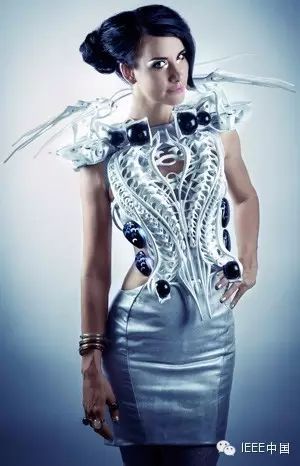New conference services and user services have been added to provide fans with IEEE conference inquiries, popular conferences, and peer searches. Welcome to try!

Author: Stephen Cass
The current trend of wearable computing is mostly about turning electronic smart devices into fashionable accessories such as bracelets, wristbands, gloves, shoes, and glasses. Meanwhile, the clothes we wear have clearly not been touched by this digital transformation. Anouk Wipprecht is at the forefront, leading high-tech designers to change this situation. She is creating clothing that can sense the wearer and their surroundings and respond accordingly.
Like most high-end fashion designs, Wipprecht’s design schemes are more about sparking discussion than striving to create ready-to-wear garments that can be sold in stores. Currently, she is using her conceptual designs to explore what clothing can actually be designed to look like, constantly pushing the boundaries of traditional garment functions—protection and display—using increasingly sophisticated technology. For example, the main part of her design “Spider Dress 2.0” features a 3D printed skeleton with sensors and motorized “limbs.” If someone stands too close to the wearer or approaches too quickly, invading the wearer’s personal space, these “limbs” will extend to reconstruct a comfortable area.
“Spider Dress 2.0” was jointly created by Wipprecht and Intel, embedding Intel’s newly launched Edison chip as a striking showcase. In her continuous search for and expansion of what she calls “fashion technology,” Wipprecht has established partnerships with several tech companies, with Intel being one of them.
From an early age, Wipprecht was fascinated by fashion. She said, “I find it very interesting that people use fashion to express and convey their style and identity.” At the age of 14, she began working with textiles and designing, and within a few years, she successfully entered the fashion industry in her native Netherlands. “My parents were not wealthy, so I had to teach myself.” Wipprecht said that without access to expensive fabrics or tools, she “had to be creative.” But she was increasingly dissatisfied: “A few years later, I started to get bored with the existing fabrics because they were completely non-interactive and did nothing… so I began to study robotics.”
Wipprecht is particularly interested in robotics that can closely relate to human experiences. She explained, “I don’t want a robot like R2-D2; I want a robot that can see and perceive its surroundings like we do.”
As part of her robotics experiments, Wipprecht started by using microcontrollers like Arduino to learn how to create various behaviors with these microcontrollers. Soon, she brought her experience into the fashion field: “I started incorporating tiny motors into the fabric, allowing the fabric to move and ripple.” As her fashion experiments continued to improve and develop, Wipprecht stated she “began to notice that system behavior was very important, so she specially studied interactive design.” At that time, she went to Sweden to study under David Cuartielles, one of the founders of Arduino, to learn more about electronics.
Wipprecht’s designs have attracted considerable attention on the international stage, especially after being invited to design the interactive performance outfit for the lead singer of the Black Eyed Peas for their 2011 Super Bowl halftime show. Later, she began coordinating increasingly complex sensors in her designs to respond to the wearer’s brainwaves. One typical example is her design “Synapse.”
In fact, the current available technology has allowed Wipprecht to find various technical-industrial partners, but she has never been satisfied with that. She hopes that the clothing she designs can be smarter and more perceptive, functioning like a second skin for the wearer. She continuously expands the awareness range of her designed clothing from both physical distance and perceptual depth. Now, Wipprecht is starting to explore how to use machine learning technology to enable her designed clothing to respond intelligently and cleverly to the wearer’s social experiences. Currently, she is collaborating with Google on a project.
Wipprecht has found that the key to her success lies in her curiosity, willingness to work across disciplines, and having clear goals. “As long as it captures your attention, go for it,” she said. “Many engineers ask me, ‘What if I don’t understand design?’ I tell them just to start doing it. At the same time, many designers ask me, ‘What if I don’t understand technology?’ Then just go buy an Arduino microcontroller and embrace the fashionable mindset: just do it. Keep experimenting, keep exploring. But, if you lack a clear goal in your mind, it’s very difficult to succeed.”


Long press to recognize the QR code and follow us